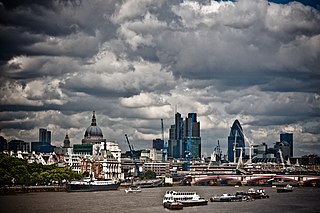Bankruptcy is a legal process through which people or other entities who cannot repay debts to creditors may seek relief from some or all of their debts. In most jurisdictions, bankruptcy is imposed by a court order, often initiated by the debtor.
Liquidation is the process in accounting by which a company is brought to an end in Canada, United Kingdom, United States, Ireland, Australia, New Zealand, Italy, and many other countries. The assets and property of the company are redistributed. Liquidation is also sometimes referred to as winding-up or dissolution, although dissolution technically refers to the last stage of liquidation. The process of liquidation also arises when customs, an authority or agency in a country responsible for collecting and safeguarding customs duties, determines the final computation or ascertainment of the duties or drawback accruing on an entry.
A number of legal systems make provision for companies trading while insolvent to be unlawful in certain circumstances, and provide for directors to become personally liable for a company's debts if they have acted improperly. In most legal systems, the liability in respect of unlawful transactions only extends for a certain period of time prior to the company going into liquidation.

In accounting, insolvency is the state of being unable to pay the debts, by a person or company (debtor), at maturity; those in a state of insolvency are said to be insolvent. There are two forms: cash-flow insolvency and balance-sheet insolvency.

The Insolvency Service is an executive agency of the Department for Business, Energy and Industrial Strategy with headquarters in London. It has around 1,700 staff, operating from 22 locations across Great Britain.
Wrongful trading is a type of civil wrong found in UK insolvency law, under Section 214 Insolvency Act 1986. It was introduced to enable contributions to be obtained for the benefit of creditors from those responsible for mismanagement of the insolvent company. Under Australian insolvency law the equivalent concept is called "insolvent trading".
In law, a liquidator is the officer appointed when a company goes into winding-up or liquidation who has responsibility for collecting in all of the assets under such circumstances of the company and settling all claims against the company before putting the company into dissolution. Liquidator is a person officially appointed to 'liquidate' a company or firm. Their duty is to ascertain and settle the liabilities of a company or a firm. If there are any surplus, then those are distributed to the contributories.

Re Barings plc [2000] 1 BCLC 523 is a leading UK company law case, concerning directors' duties of care and skill. The case is formally identified and cited as "No 5", though some observers regard it as the sixth in the saga of litigation concerning Barings Bank.

The United Kingdom company law regulates corporations formed under the Companies Act 2006. Also governed by the Insolvency Act 1986, the UK Corporate Governance Code, European Union Directives and court cases, the company is the primary legal vehicle to organise and run business. Tracing their modern history to the late Industrial Revolution, public companies now employ more people and generate more of wealth in the United Kingdom economy than any other form of organisation. The United Kingdom was the first country to draft modern corporation statutes, where through a simple registration procedure any investors could incorporate, limit liability to their commercial creditors in the event of business insolvency, and where management was delegated to a centralised board of directors. An influential model within Europe, the Commonwealth and as an international standard setter, UK law has always given people broad freedom to design the internal company rules, so long as the mandatory minimum rights of investors under its legislation are complied with.

United Kingdom insolvency law regulates companies in the United Kingdom which are unable to repay their debts. While UK bankruptcy law concerns the rules for natural persons, the term insolvency is generally used for companies formed under the Companies Act 2006. "Insolvency" means being unable to pay debts. Since the Cork Report of 1982, the modern policy of UK insolvency law has been to attempt to rescue a company that is in difficulty, to minimise losses and fairly distribute the burdens between the community, employees, creditors and other stakeholders that result from enterprise failure. If a company cannot be saved it is "liquidated", so that the assets are sold off to repay creditors according to their priority. The main sources of law include the Insolvency Act 1986, the Insolvency Rules 1986, the Company Directors Disqualification Act 1986, the Employment Rights Act 1996 Part XII, the Insolvency Regulation (EC) 1346/2000 and case law. Numerous other Acts, statutory instruments and cases relating to labour, banking, property and conflicts of laws also shape the subject.
Re a Company [1990] BCC 526 is a UK insolvency law case, on the offence of fraudulent trading under s.213 of the Insolvency Act 1986.

The Company Directors Disqualification Act 1986 forms part of UK company law and sets out the procedures for company directors to be disqualified in certain cases of misconduct.

Re Produce Marketing Consortium Ltd [1989] 5 BCC 569 was the first UK company law or UK insolvency law case under the wrongful trading provision of s 214 Insolvency Act 1986.

Re MC Bacon Ltd [1990] BCLC 324 is a leading UK insolvency law case, concerning transactions at an undervalue and voidable preferences.
Pre-packaged insolvency is a kind of bankruptcy procedure, where a restructure plan is agreed in advance of a company declaring its insolvency. In the United States pre-packs are often used in a Chapter 11 filing. In the United Kingdom, pre-packs have become popular since the Enterprise Act 2002, which has made administration the dominant insolvency procedure. Such arrangements are also available in Canada under the Companies' Creditors Arrangements Act.

British Eagle International Air Lines Ltd v Cie Nationale Air France [1975] 1 WLR 758 is a UK insolvency law case, concerning priority of creditors in a company winding up.

Re Yeovil Glove Co Ltd [1965] Ch 148 is a leading UK insolvency law case, concerning voidable floating charges for past value. It holds that a floating charge can harden when it secures a debt in an overdraft account, when the bank keeps the facility open as a company takes money out and puts money in.

Re Brian D Pierson (Contractors) Ltd [1999] BCC 26 is a UK insolvency law and company law case, concerning misfeasance and wrongful trading.
Administration in United Kingdom law is the main kind of procedure in UK insolvency law when a company is unable to pay its debts. The management of the company is usually replaced by an insolvency practitioner whose statutory duty is to rescue the company, save the business, or get the best result possible. It is the equivalent of Chapter 11, Title 11, United States Code, although with significant differences. While creditors with a security interest over all a company's assets could control the procedure previously through receivership, the Enterprise Act 2002 made administration the main procedure.

Brooks v Armstrong[2016] EWHC 2289 (Ch), [2016] All ER (D) 117 (Nov) is a UK insolvency law case on wrongful trading under section 214 of the Insolvency Act 1986.












